CHINESE SCRIPT
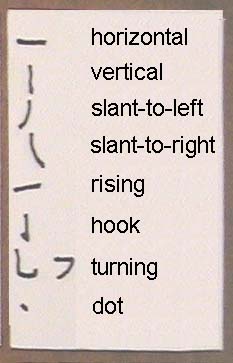
Writing Chinese Characters.
Eight basic strokes are used to construct Chinese characters. They are:
1. the horizontal stroke
2. the vertical stroke
3. the stroke slanting to the left
4. the stroke slanting to the right
5. the rising stroke
6. the hook
7. the turning stroke
8. the dot
Horizontal strokes begin at the left and are drawn toward the right. Vertical strokes go from the top toward the bottom.
Generally, horizontal strokes are are drawn before vertical strokes. One exception is in drawing the box, where the left vertical side is drawn first, then the top horizontal is made and turns downward to form the right side of the box. Internal features are then added (if any) and the bottom horizontal stroke is drawn.
We can then conclude that a simple 4-sided box is, as a practical matter, drawn with three strokes. This distinction becomes important in the classification of radicals, where the “mouth" radical and the “surround" radical, both boxes, are classified in the three-stroke category.
The turning stroke has sub-types, such as the “sickle” and the “back-turned” stroke.
Radicals as a historic means of indexing.
Chinese characters are drawn from the basic strokes listed above. However another level of classification is needed to help sort out the thousands of characters and list them in all-Chinese dictionaries in an orderly way. The intermediate level is called the “radical system”, or “radical systems”, since there are variations among them. Radicals are recurring, recognizable sub-assemblies of strokes. Depending on the particular implementation, there are from 180 to 230 radicals. Some radicals appearing in this word list are: the “one” radical (one horizontal stroke), the “person” and “side-man” radicals (2 strokes) and the “ear” radical (2 strokes).
Fast-finder indexing.
Chinese characters are drawn in such a way as to occupy unseen, uniform squares of space. Some characters occupy the whole square, with no apparent subdivision. Many more Chinese characters are compounds consisting of a left part and a right part, or a top part and a bottom part. The Fast-finder book lists characters according to what appears in either part. Other subdivisions are also listed, as well as undivided characters which occupy the whole square. The main part of the Fast-finder book is devoted to simplified characters. In the Appendix, traditional characters are listed. See "Finder" below under "References".
Modern English/Chinese bilingual dictionaries.
Shortly after 1949, when the Communist Party came into power, reforms were made to the Chinese script which resulted in the simplified characters. As a result, simplified characters are official in mainland China and Singapore, while traditional characters prevail in Taiwan, Hong Kong, and outlying Chinese communities around the world.
Unlike Japan, which has its own phonetic alphabets that complement its “kanji” (Japanese word for its own version of Chinese script), China did not have a phonetic script of its own. The Peoples Republic of China adopted a Roman-alphabet based phonetic script called, in the characters of its own script, Pīnyīn. That solved the problem of organizing the Chinese section of the English-Chinese dictionary: the Chinese words are alphabetized according to the Pīnyīn romanization.
The four stressed tones.
The are four kinds of tone for stressed syllables, and there is one neutral, unstressed tone, sometimes called the fifth tone.
Tone 1. As in tā, is high and level in pitch. Imagine a sports contest where someone yells “time”.
Tone 2. As in rén, start at mid-level and rises sharply, like saying a surprised “huh”?
Tone 3. As in yě, starts in low mid-range, and falls even lower, before rising to a point higher than where it started. I call this one U-shaped.
Tone 4. As in gè, starts at the top of the range and falls abruptly all the way to the bottom, like saying with impatient agreement: “right”.
Pīnyīn uses four diacritical marks to indicate the tones, as shown sbove in tā, rén, yě, and gè. The shape of the mark corresponds to the shape of the tone.
My website project.
The one-hundred most-used Chinese characters on the Web are mostly simplified characters, but a sprinkling of traditional characters does occur.
I have looked up all 100 characters in the Fast-finder and printed them on study-cards. If the character was traditional, the simplified character was also shown on the card. It is these 100 cards that are the basis of this Chinese section of my website. Practice Group 1 lists seven characters from the study-cards, and adds four more characters needed to make sample sentences.
References:
I often refer to the [fast] “Finder”:
Laurence Matthews, Chinese Character Fast Finder -- Simplified Characters, Tuttle Publishing, 2004.
I often refer to “RWC”, and always mean the “Simplified Character Edition”:
William McNaughton, Reading and Writing Chinese -- Simplified Character Edition, Tuttle Publishing, Singapore, 2005.
I occasionally refer to “Lang.”:
Langenscheidt Pocket Mandarin Chinese Dictionary, Langenscheidt KG, Berlin, 2005.
PRACTICE GROUP 1
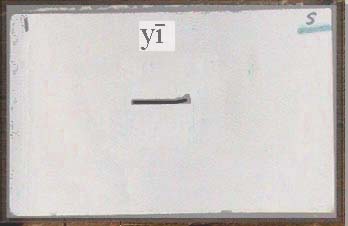
- one
Drawing instructions:
The horizontal stroke is drawn from left to right.
Pronunciation.
The ‘y’, blending in, is scarcely heard. The word sounds like the ‘ea’ in easy. Use tone 1, high and flat.
Reference:
Fast-finder page 39, side A, row 1.
R&WC Simplified Char. Ed. - Character #1.
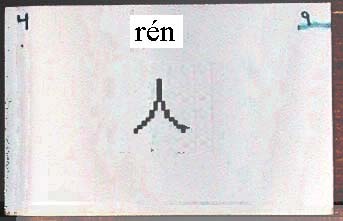
- person; human being; people; man
Drawing instructions:
1. The left stroke, slanting to the left, is drawn first.
2. The right stroke, slanting to the right, completes the character.
This character is the precursor of a few radicals. It can appear on the right, on the top, or as a is a “side-man” on the left. When on the left, the “man” gets compressed toward the left portion of the square drawing area, and the second stroke becomes a true vertical. All three versions can be seen in the composite characters below.
Pronunciation. The retroflex ‘r’ is used. Something like ‘rjen’, a purr. Use tone 2, rising.
Reference:
Fast-finder page 39, side B, row 3.
R&WC Simplified Char. Ed. - Character #4.
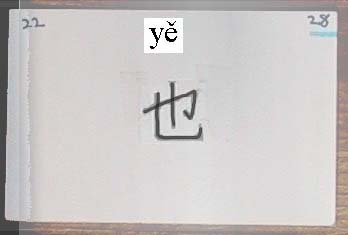
- also
1. A rising stroke continues into a deep back-turned stroke, which ends in a hook.
2. A central vertical stroke is drawn.
3. A sickle stroke completes the character.
Pronunciation.
The ‘ye’ is as in English ‘yet. Use tone 3, “U” shaped, dipping down from mid-range, then rising.
Reference:
Fast-finder page 40, side A, row 2.
R&WC Simplified Char. Ed. - Character #22.
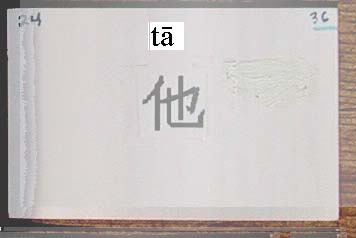
- he
Drawing instructions:
This is a compound of the side-man radical and the “also” character.
1. A left-slanting stroke is made for about one-third of the way downward.
2. From the midpoint of this stroke, a vertical is extended to the bottom.
3. thru 5. A rising stroke then begins the three strokes of the “also” character, which must be narrowed a bit to fit into the remaining space.
Pronunciation. The ‘t’ gets extra breath. the ‘a’ as in father. Use tone 1, high and flat.
Reference:
Fast-finder page 9, side A, row 5.
R&WC Simplified Char. Ed. - Character #24.
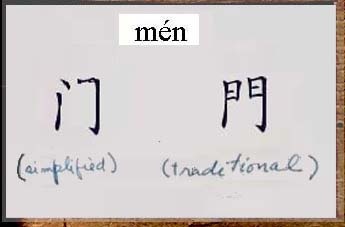
- door; the gate radical
The traditional character is shown on the right:
Drawing instructions for the simplified character shown on the left:
1. The dot, and
2. vertical stroke is made.
3. Then the back-turned stroke is made, drawing to the right, then angling down and ending with a hook.
Pronunciation.
Similar to English, it presents no problems. Use tone 2, rising.
Reference:
R&WC Simplified Char. Ed. - Character #25.
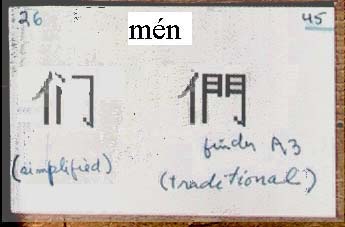
- the pluralizing particle
Drawing instructions:
1. Starting at the top left, the downward left-slanting stroke is made, then
2. a true vertical stroke completes the “side-man” radical.
3. The mid-portion dot, and
4. vertical stroke are then made.
5. Finally the back-turned stroke is made, drawing to the right, then angling down and ending with a hook.
Pronunciation.
Similar to English, it presents no problems. Use tone 2, rising. Occasionally, it also appears toneless.
References:
Fast Finder - Both characters are classified under the “side-man” radical. The traditional character is seen in the finder’s Appendix, page A3, side A, row 2. The simplified character is in the main portion of the finder, page 9, side B, row 2.
R&WC Simplified Char. Ed. - Character #26.
Langenscheidt’s Pocket Dictionary - This character does not appear as a separate entry. It does appear with other words as a suffix.

- the generic measure-word
Drawing instructions for the simplified character:
1. Starting at the top, the downward left-slanting stroke is made, then
2. a right-sloping stroke completes the “person” radical.
3. The vertical stroke completes the character.
Pronunciation. The ‘g’ is hard. The ‘e’ as in her. or the French article ‘le’. Use tone 4, falling.
Reference:
Fast-finder: The traditional character is seen in the finder’s Appendix, page A3, side A, row 9. The simplified character is in the main portion of the finder, page 59, side B, row 1.
R&WC Simplified Char. Ed. - Character #214.
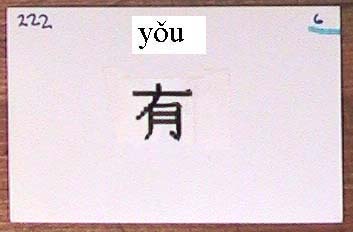
- have
Drawing instructions:
1. The upper horizontal stroke is made first, then
2. the downward left-slanting stroke is made.
3. Bisecting the lower portion of the latter, another downward left-slanting stroke is made.
4. From the same intersection, a horizontal stroke continues into a deep back-turned stroke, which ends in a hook.
5. A horizontal stroke, and below it
6. another horizontal stroke complete the character.
Pronunciation.
Unlike the English word, it sounds like the yo in yo-yo. Use tone 3, “U” shaped, dipping down from mid-range, then rising.
Reference:
Fast-finder page 32, side A, row 7.
R&WC Simplified Char. Ed. - Character #222.
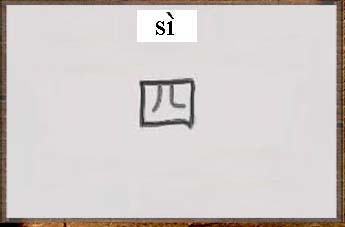
- four
Drawing instructions:
1. A vertical stroke downward forms the left side of the box.
2. A back-turned stroke forms the top and right side of the box.
3. The first interior feature of the box is a left-sloping stroke.
4. The second interior feature is a downward stroke, curving sharply to the right.
5. A horizontal stroke completes the box and the character.
Pronunciation. Rule: the ‘i’ is diminished whenever it follows a retroflex, or ‘c’, ‘s’, or ‘z’. Like the English "si" in sir". Use tone 4, falling.
Reference:
R&WC Simplified Char. Ed. - Character #199.
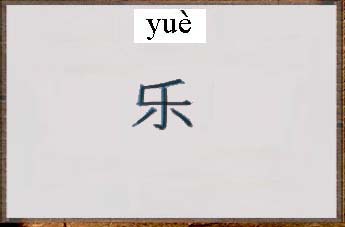
- music
Drawing instructions:
1. Begin near the top with a rising stroke.
2. Then, at the left, make a vertical stroke which turns sharply into a horizontal stroke. .
3. The central vertical stroke is then drawn downward from the top, and ends in a hook.
4. A short left-slanting stroke and
5. a short right-slanting stroke complete the character.
Pronunciation. This is like English "yoo" plus "eh" as in "bed" -- "yoo-eh". Use tone 4, falling.
Reference:
R&WC Simplified Char. Ed. - Character #988.
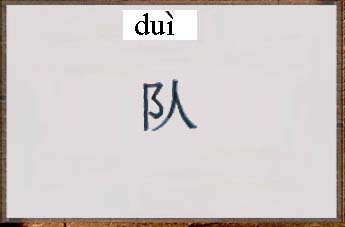
- group; team
Drawing instructions:
1. Begin at the upper left with a short horizontal stroke, which curves sharply downward to form the curved portion of the "ear".
2. Then, at the left, make a vertical stroke, which completes the ear.
3. The "person" radical is made with a full-length left-slanting stroke, followed by
4. a stroke slanting to the right.
Pronunciation. Part of the “b, d. g” group, the "d" is neither strongly voiced, nor strongly aspirated in Chinese. The "ui" of Pinyin is like English "way". So the syllable would sound like a cross between "dway" and "tway". Use tone 4, falling.
Reference:
R&WC Simplified Char. Ed. - p.236a
BUILDING SENTENCES
We have eleven characters in all. They are: yī, rén, yě,
tā, mén, mén, gè, yǒu, sì, yuè, and duì.
They mean: one, person, also, he, door, the pluralizing particle, the generic measure-word, have, four, music. and group. Before attempting to construct sentences, here are some rules about how some of these words can be used in Chinese.
1. Words for “a” and “the” do not exist in Chinese, and are supplied as needed in the English translation.
2. Measure-words. To specify the number of objects, an extra word is needed called a “measure-word”, often abbreviated MW. The MW will follow the numeral and precede the name of the object(s). There are many specific types of MW’s in Chinese. Just as we say four “head of cattle”, and five “flakes of snow”, we do not say “five head of snow” or “four flakes of cattle”; that is, we pick the approproate MW. Gè is the generic MW, meaning that it can pass (in a pinch) for a more specific MW.
3. The verb “have”. Unlike European languages, with their conjugations, there is only one form of the verb.
4. Person, people. Usually there are no special plural forms. Rén can mean a person or people.
5. Adverbs - yě. The adverb is placed directly in front of the verb that it modifies.
6. Compound words. The word for music and the word for group can be written together in Pīnyīn to mean “musical group” or “band” -- yuèduì. In Chinese script, such characters are separated by a space, just like any other two characters.
7. Personal pronouns occur in singular forms which can be pluralized by adding the pluralizing particle -- thus, tā (he) becomes tāmén (they).
With these rules in mind, let us construct three simple sentences, using the words in this lesson. Note that the first sentence requires all four tones in the following order - even (tone 1), U-shaped (tone 3), even (tone 1), falling (tone 4), and rising (tone 2). These tones are essential to the understanding of the sentence in spoken Mandarin Chinese.
Scenario.
My imaginary wife asked me what happened when I went to see Ralph at the lumber-yard to look at doors. I said:
Tā yǒu yī gè mén.
The student should attempt to write the sentence as an exercise using Chinese characters.
Translation into English is also left to the student.
My wife then asked: “And what about Home Depot?”
I replied with the second sentence, which is two words longer:
Tāmén yě yǒu yī gè mén.
Write this one in Chinese, too. The translation is: “They also have one door.”
The third sentence answers the question: “How many people are there in the band?”
Yuèdui yǒu sì gè rén.
Write this one in Chinese, then compare your answers with the three sentences displayed below.
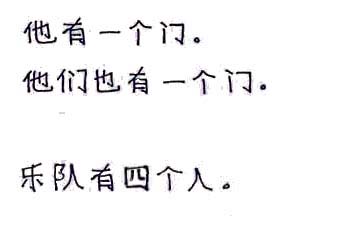
- Three sentences
Tā yǒu yī gè mén.
Tāmén yě yǒu yī gè mén.
Yuèdui yǒu sì gè rén.
He has one door.
They also have one door.
The band has four people.
This concludes, for the moment, the introduction to Chinese on my website.
A separate webpage deals with pronouncing all the Pinyin letter-combinations.
1/19/2010